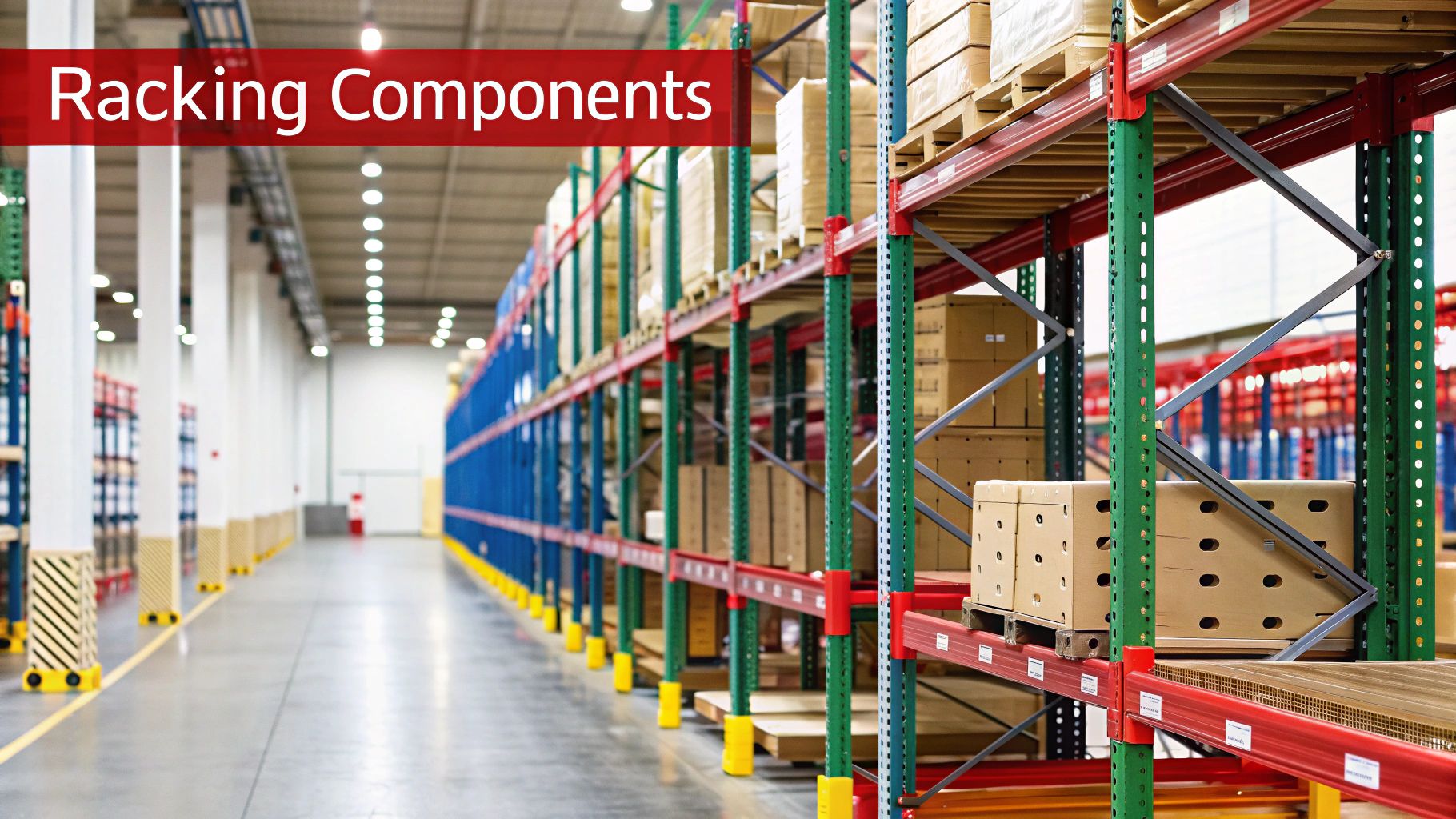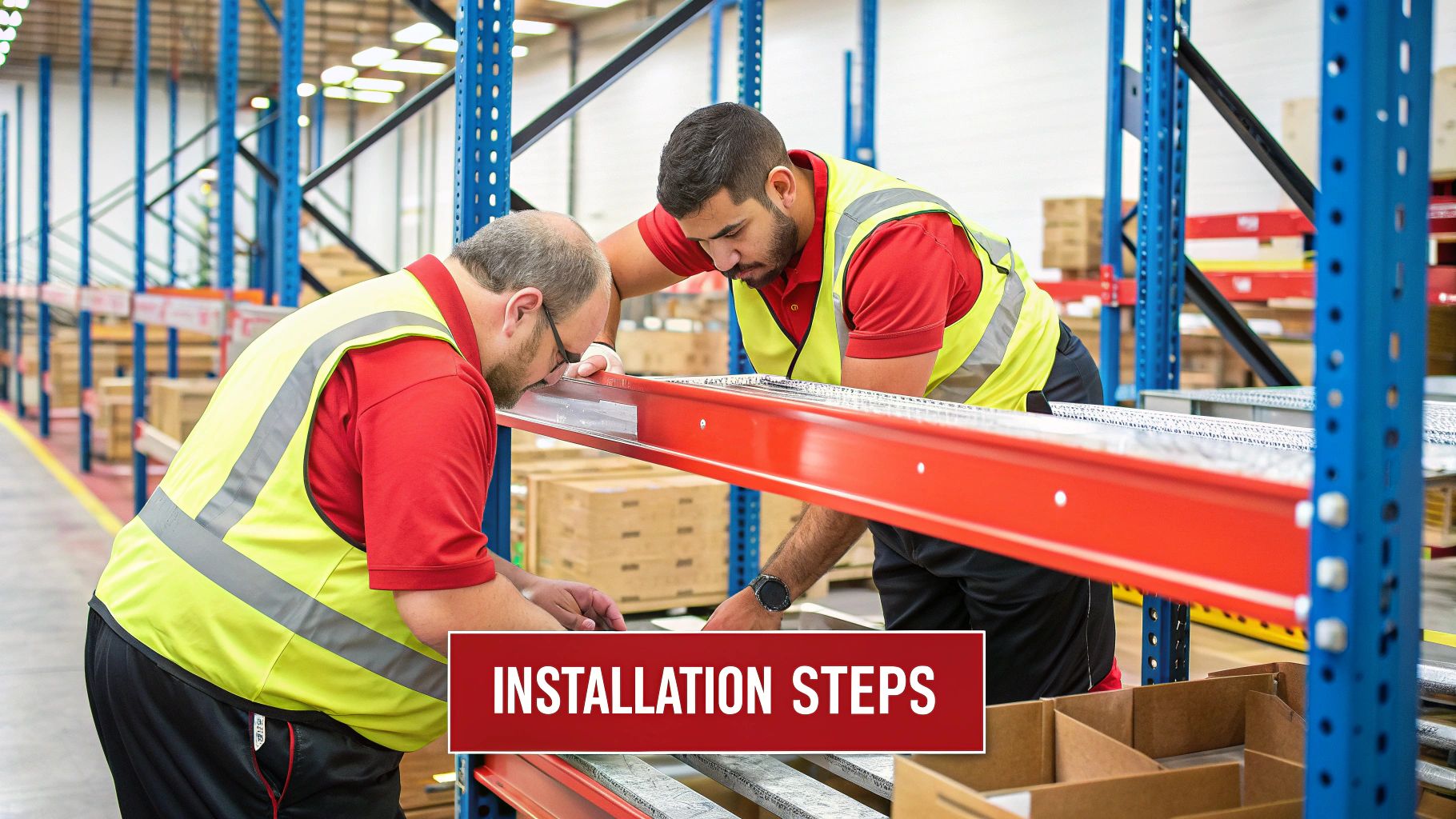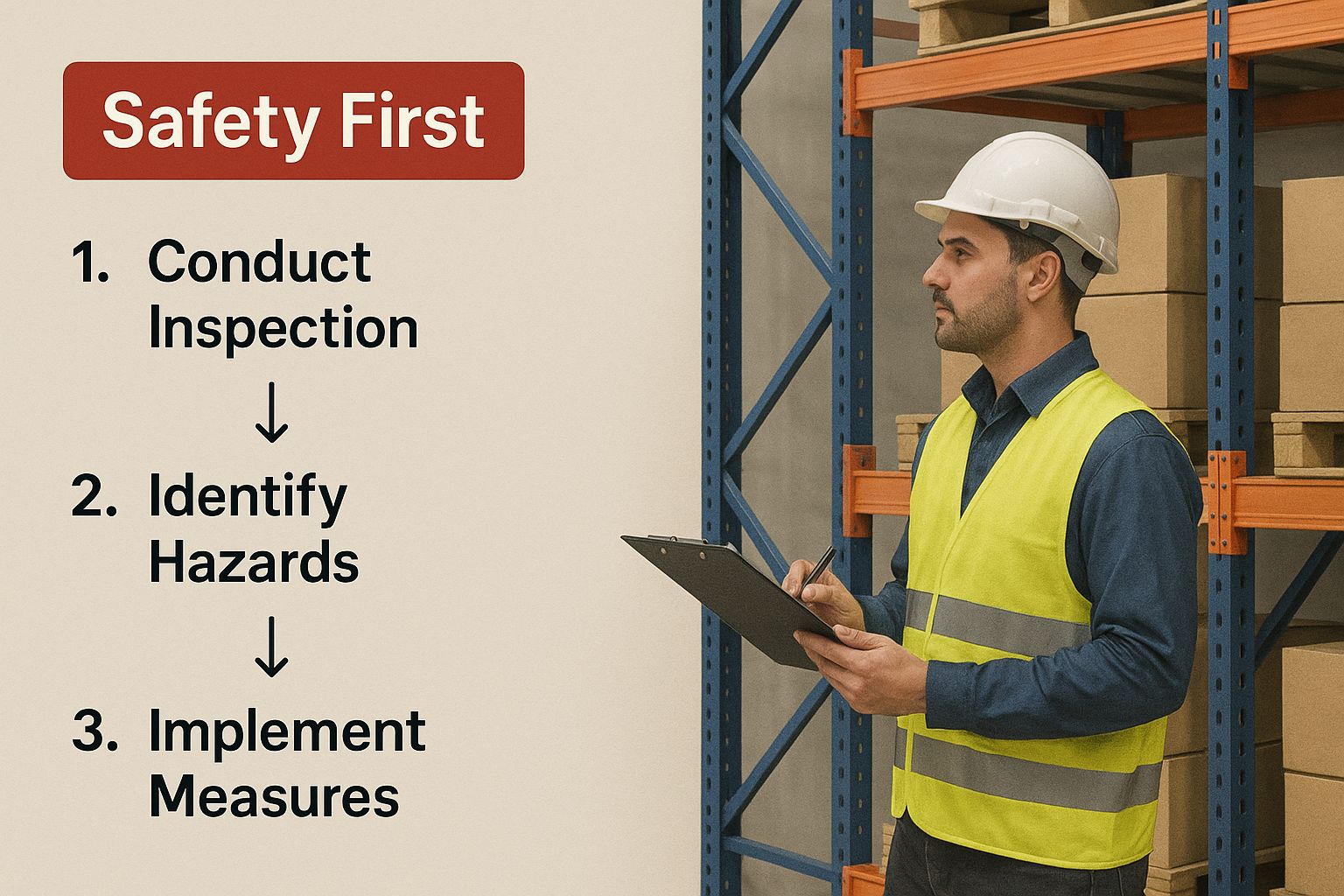A successful pallet racking installation is about much more than just slotting beams into frames. It’s the foundation of a safe, organised, and efficient warehouse. Getting it right from the start saves you from costly mistakes, keeps your team safe, and maximises your storage potential.
Think of a solid pallet racking plan as your non-negotiable first step. It doesn’t matter if you’re fitting out a massive distribution centre in Melbourne or setting up a few bays in a rural Queensland farm shed—meticulous planning is what separates a smooth, safe setup from a chaotic one. This stage ensures a streamlined workflow and full compliance with Australian safety standards.
The demand for these storage systems is booming. The global pallet racking market is tipped to grow from AUD 16.49 billion in 2025 to a huge AUD 29.25 billion by 2035. This shows just how essential efficient storage is for any modern business.
One of the first big decisions you’ll make is whether to go new or second-hand. While used racking might look like a bargain, it often comes with a heap of risks. You’re dealing with an unknown history, potential hidden damage, and the real possibility it won’t meet the current, strict Australian Standard AS 4084-2023.
Investing in a new, high-quality system from a trusted supplier like Super Rack is a far smarter move for the long haul. Here’s why:
When it comes to structural integrity and making sure your system lasts, it’s always best to rely on professional manufacture and installation services for your pallet racking. This guarantees your system isn’t just built tough, but is also assembled to the highest safety specs.
By starting with a clear plan and choosing quality new materials, you’re building a storage solution you can trust. This guide will walk you through all the key steps, helping you turn your space into a genuinely functional and productive asset.
Before a single tool comes out, getting your layout plan right is the most critical part of a successful pallet racking installation. This isn’t just about making everything fit; it’s about designing a workflow that’s safe, efficient, and squeezes the most out of every square metre.

It all starts with getting the tape measure out. You need to map your entire floor space, paying close attention to every permanent fixture that could get in your way. I’ve seen it happen time and again—people forget the small things, which turn into big headaches later.
Pay close attention to these often-overlooked obstructions:
Once your fixed points are on the map, it’s time to think about movement. Your aisle width is one of the most important calls you’ll make, directly impacting both safety and efficiency. A tight aisle is an accident waiting to happen and will slow down your entire operation.
For example, a busy Brisbane logistics hub running large reach trucks will need much wider aisles than a small workshop that only uses a pallet jack. A good rule of thumb is to check your forklift’s spec sheet for its minimum turning radius, then add at least 300mm of clearance on either side for safe operation.
With your space and traffic flow sorted, you can focus on the racking itself. To do this properly, you need a crystal-clear picture of your inventory. Don’t just guess how many pallet spaces you need—base it on real data.
Ask yourself these questions:
Thinking through these details helps you choose the right system from the get-go. You can explore different configurations and weight capacities in Super Rack’s extensive range of pallet racking to find the perfect match. This careful planning transforms an empty floor into a highly productive asset.
A smooth pallet racking installation comes down to solid preparation. Getting your site and team ready long before the first frame goes up prevents delays, avoids costly mistakes, and keeps everyone safe. It’s all about laying the proper groundwork.

First things first: check your foundation. Your concrete floor slab needs to be strong enough to handle the immense point loads of fully loaded racking. It’s something people often overlook, but a slab that can’t take the weight is a recipe for disaster.
Before you do anything, get the slab’s thickness and load-bearing capacity verified by an engineer if you’re not 100% sure. This is crucial for a big project, like a new warehouse in Perth, but it’s just as critical for farmers setting up cattle yards that need to store heavy equipment. A clean, level surface is also a must.
To make sure you don’t miss anything, we’ve put together a quick checklist to get your site and crew ready.
| Check Area | Task Description | Why It’s Important |
|---|---|---|
| Foundation | Verify concrete slab thickness and load-bearing capacity. | Prevents slab failure, which can lead to catastrophic racking collapse. A strong base is critical for safety. |
| Surface | Clear the entire installation area of debris, old equipment, and rubbish. | A clean area allows for accurate layout marking and prevents trip hazards for the installation team. |
| Levelling | Check the floor for levelness. Address any significant slopes or cracks before starting. | Ensures frames are installed perfectly vertical, which is essential for structural stability and load distribution. |
| Tools | Gather all required tools: impact drivers, torque wrenches, laser levels, and lifting equipment. | Having everything on hand prevents delays and ensures every component is tightened to manufacturer specs. |
| PPE | Ensure every team member has the required PPE: hard hats, high-vis clothing, steel-capped boots, and gloves. | Personal safety is paramount. Proper PPE protects your crew from common on-site injuries. |
| Briefing | Conduct a pre-start safety briefing to review the plan, assign roles, and discuss hazards. | Aligns the entire team on safety protocols and the day’s workflow, minimising misunderstandings and risks. |
This isn’t just about ticking boxes; it’s about building a foundation of safety and efficiency right from the start.
With the site cleared and confirmed, tackle your tools and team. Having the right equipment ready means the job gets done right, and on time. A professional setup needs more than just a basic toolkit.
Your crew is going to need these essentials:
Having all your gear ready saves an incredible amount of time and keeps the project running like clockwork.
Lastly, get the whole team together for a pre-start safety briefing. This quick meeting is your chance to run through the assembly plan, making sure everyone understands their role and the key safety protocols for the day.
A pre-start briefing ensures every team member knows the plan, the potential hazards, and their responsibilities. It’s the single best way to align your crew and kick off a pallet racking installation with safety as the top priority.
This is the perfect time to confirm that everyone knows how to handle the heavy-duty components from Super Rack and understands why installing safety features correctly is so important. This small investment of time pays off big time in safety and efficiency.
Right, your site is prepped and the plans are finalised. Now for the hands-on part: bringing that pile of steel to life and building your pallet racking installation. Let’s walk through how to assemble it properly, without the jargon.
It all starts with building the frames, which are the vertical backbone of the whole system. Lay two uprights on a clean, flat floor, then attach the horizontal and diagonal braces. Bolt them in securely, but leave them slightly loose for now—this gives you wiggle room to make sure everything is perfectly square before the final torque-down.
Once a frame is assembled, stand it up. Use temporary bracing to hold it steady while you build the second frame. With two frames standing, you’re ready to connect them with the first set of cross beams. This sets the width and stability for your first bay.
Always install beams from the bottom up. For a warehouse manager in Sydney setting up a new distribution point, this methodical approach keeps the structure stable as it gets taller. As you clip beams into the teardrop slots, get those safety locking pins in straight away. They’re what stop a beam from getting knocked out by an accidental forklift bump.
As you build, keep checking that the whole thing is plumb (perfectly vertical) and square. A laser level is your best mate here. Even a slight lean can throw off the load capacity, so don’t just eyeball it. A few gentle taps with a rubber mallet will help nudge the beams into a snug, perfectly aligned fit.
This infographic breaks down the key safety checks to keep in mind during assembly.

Putting safety first at every step ensures each component works exactly as it should, creating a reliable structure from the ground up.
Once the first bay is standing, perfectly plumb, and every beam has its locking pin, go back and torque all the frame bolts to the manufacturer’s specs. Now you’re ready to move on to the next bay, connecting it to the first to build out your row.
Final anchoring is the last and most critical step. Once a row is complete, you must drill into the concrete slab and secure the upright footplates with the correct anchor bolts. This permanently fixes the system to the floor, preventing any tipping or movement.
This detailed approach is vital, especially with Australia’s booming e-commerce sector driving demand for solid storage solutions. The Australian pallets market was valued at around AUD 1066.39 million in 2024 and is expected to hit AUD 1.60 billion by 2034. Building your system with precision means it’ll be ready to handle the demands of this fast-paced industry.
Just because you’ve tightened the last bolt, it doesn’t mean your pallet racking installation is finished. The final checks and a solid ongoing maintenance plan are what truly protect your team, your stock, and your investment for the long haul. This is the last critical step to ensuring your system is safe and compliant.
Before you load a single pallet, it’s time for a thorough final inspection. Walk every aisle and check every component. You’re looking for consistency and security across the entire structure. This isn’t a quick glance; it’s a detailed review to catch any potential issues.
Your final check needs to be methodical. Grab your installation plan and a torch, and look closely at the details. This is where the quality of new racking from Super Rack really shows its value—you can be confident in the integrity of every part, unlike the risks with second-hand gear.
Here’s a simple checklist to follow:
Once your racking is in use, safety is a continuous process. Damage can happen—most commonly from forklift impacts—so a proactive maintenance schedule is non-negotiable. For long-term durability, it’s crucial to implement a robust plan, starting with understanding preventive maintenance principles.
A regular inspection routine is your best defence against structural failure. Small dents and scrapes might seem minor, but they can compromise the load-bearing capacity of an upright and lead to a serious incident if ignored.
A simple yet effective schedule keeps you ahead of any issues. Daily checks can be informal observations by forklift operators, while weekly inspections should be a more focused visual check for any obvious damage.
Annually, it’s best practice to get a professional assessment. You can learn more about what’s involved in Super Rack’s guide to a pallet racking audit. This thorough approach keeps your warehouse safe and compliant.
While standard racking is common, the market is also seeing growth in specialised systems. For instance, mobile pallet racking systems represent a growing niche within the broader pallet racking installation market, which expanded from AUD 683.92 million in Asia Pacific in 2021 to an expected AUD 925.95 million by 2025. This highlights the importance of maintaining any system, simple or complex, to protect its value.
Got a few lingering questions about setting up your pallet racking? Good. It pays to be thorough. Here are some straight answers to the questions we hear most often from business owners around Australia.
It can be tempting to DIY a smaller setup, but for most projects, we strongly recommend bringing in a professional. For anything large or complex, it’s essential. An expert installer makes sure every component is assembled correctly, anchored securely, and is fully compliant with Australian Standard AS 4084-2023.
This isn’t just about meeting regulations. It’s about guaranteeing the system is safe for your team and keeping your business covered for insurance purposes. A professional build offers peace of mind a DIY job just can’t provide.
Getting the weight capacity right is non-negotiable for safety. First, figure out the absolute heaviest a fully loaded pallet will be in your operation. Then, multiply that number by how many pallets you intend to store on each beam level.
Never guess. Always work off the supplier’s certified load ratings. At Super Rack, our team is always on standby to help you calculate your exact requirements for our heavy-duty gear and avoid dangerous overloading.
Regular inspections are your number one defence against accidents. Get your team doing quick, informal visual checks every week. They should be looking for obvious dings, dents, or scrapes on the uprights—usually the first signs of a forklift impact.
On top of that, you’ll need a thorough inspection by a competent person at least once every 12 months. Any damage found, no matter how minor it seems, needs to be reported and dealt with immediately to eliminate any risk of collapse.
Choosing new racking over second-hand is one of the smartest safety decisions you can make. New pallet racking from a trusted supplier like Super Rack guarantees full compliance with current safety standards, comes with a proper warranty, and has a clear, certified load capacity. Second-hand racking carries an unknown history, potential hidden damage, and significant safety risks.
Investing in new, quality-assured racking isn’t an expense—it’s an investment in your people’s safety and your inventory’s security. For more handy tips and in-depth guides on warehouse safety, feel free to check out the other articles on our Super Rack blog. We also supply a wide range of other solutions like garage shelving, cantilever racking, fencing, and even tiny homes.
Ready to build a safe, efficient, and reliable storage system for your business? Contact Super Rack for a free quote today and let our experts help you find the perfect solution. Visit us at https://www.superrack.com.au.
4000 to 4182
4186 to 4207
4300 to 4305
3000 To 3096
3098 To 3112
3114 To 3138
3140 To 3157
3161 To 3198
3200 To 3207
Order Delays for Temporary Fencing, Agricultural Products, Pallet Racking, Cantilever Racking and Mesh Panels
Let's connect